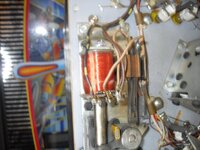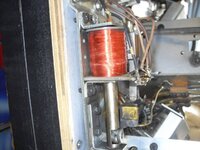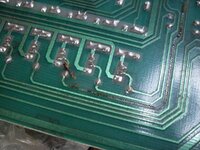Pinball info
You are using an out of date browser. It may not display this or other websites correctly.
You should upgrade or use an alternative browser.
You should upgrade or use an alternative browser.
unknown coil
- Thread starter rockhouse
- Start date
Looks like the upper left flipper coil in a vector, i have one of these games. But it is tombstoned at the moment so I can't access the coil.
But the top left flipper does not do much, it is directly connected to high voltage via the cabinet buttons and relay on the solenoid board. So i think if it works ok, I'd be inclined to leave it. You can adjust the flipper power with the end of stroke switches if need be
But the top left flipper does not do much, it is directly connected to high voltage via the cabinet buttons and relay on the solenoid board. So i think if it works ok, I'd be inclined to leave it. You can adjust the flipper power with the end of stroke switches if need be
According to the online manual the flippers coils (4) are AQ-25-500/34-4500. It's interesting that different gauge wire is used for the flipper and hold coil.
On vector i think it is critical that you adjust the eos strokes to reduce power on all 4 flippers. Vector has a reputation for air shots, this is simply because the playfield is quite crowded.
Top left too powerful = air shot up the middle mini playfield ramp
Top right too powerful = breakages and air shot
Bottom left too powerful = air shots up the right hand ramp
Bottom right too powerful = damage to vectorscan loop entrance, many games have this
I adjusted the eos on my top left, and main 2 flippers to get sensible power
I replaced the coil in the top right flipper with a less powerful one as mine broke the drop targets and the lightbulbs behind them
You will get differing opinions here from me and fellow vector brotherhood member @Nedreud . But where we agree is that on the top mini playfield a mini 2" flipper looks better, i think the game was designed for one. But in my opinion a full sized flipper plays much better. As it has three drain points, ball times in the mini playfield are so short that to actually make it a meaningful part of the game you need a full length flipper, with suitably adjusted power.
Try both flipper sizes and see which you prefer
Top left too powerful = air shot up the middle mini playfield ramp
Top right too powerful = breakages and air shot
Bottom left too powerful = air shots up the right hand ramp
Bottom right too powerful = damage to vectorscan loop entrance, many games have this
I adjusted the eos on my top left, and main 2 flippers to get sensible power
I replaced the coil in the top right flipper with a less powerful one as mine broke the drop targets and the lightbulbs behind them
You will get differing opinions here from me and fellow vector brotherhood member @Nedreud . But where we agree is that on the top mini playfield a mini 2" flipper looks better, i think the game was designed for one. But in my opinion a full sized flipper plays much better. As it has three drain points, ball times in the mini playfield are so short that to actually make it a meaningful part of the game you need a full length flipper, with suitably adjusted power.
Try both flipper sizes and see which you prefer
That coils got some knarlly soldering on it.
Makes my soldering look professional...
Makes my soldering look professional...
As long as it works id leave it alone
Are you saying you haven't turned it on yet?
This guide covers Vector and has lots of advice on checks before first switch on (if you have the will power!)
http://techniek.flipperwinkel.nl/ballyss/rep/index1.htm#list
This guide covers Vector and has lots of advice on checks before first switch on (if you have the will power!)
http://techniek.flipperwinkel.nl/ballyss/rep/index1.htm#list
not tried yet as 2 of coils were cream crackered
and the high voltage side needs some work no displays.
will probably change to led displays once i know the old displays work
then i can sell them as working.
have been following one of the guides very helpful
and the high voltage side needs some work no displays.
will probably change to led displays once i know the old displays work
then i can sell them as working.
have been following one of the guides very helpful
i know i only put it up to show what happens if you ignore a locked on coil,
i will replace transistor and the other components associated with it and also i'm
slowly sorting the rest of it just takes time waiting for bits
thanks for all the advice
i will replace transistor and the other components associated with it and also i'm
slowly sorting the rest of it just takes time waiting for bits
thanks for all the advice

Have you checked all the fuses ?
There is a 1 amp slow blow attached to the underside of the playfield that should protect against locked on coils doing board damage
For eos gaps and associated switch triggering, trial and error is the way to set them on vector
There is a 1 amp slow blow attached to the underside of the playfield that should protect against locked on coils doing board damage
For eos gaps and associated switch triggering, trial and error is the way to set them on vector
all fuses checked and right fuses in place thanks for reminding me about the under playfield oneHave you checked all the fuses ?
There is a 1 amp slow blow attached to the underside of the playfield that should protect against locked on coils doing board damage
For eos gaps and associated switch triggering, trial and error is the way to set them on vector

Hi @rockhouse! As mentioned by @DRD I'm another member of THE VECTOR BROTHERHOOD!  Between us and the rest of pinballinfo sure we can help you out.
Between us and the rest of pinballinfo sure we can help you out.
In response to your initial question, if a coil has lost it's wrapper and has no other identifying marks, then there's no way of knowing if it's exactly the right coil. Yes, you could unwind it but you'd bugger it as you'd never re-wind it as good as the original machining. As mentioned by @astyy the flipper coils are AQ-25-500/34-4500 which means they've got a double winding: one with 500 turns of 25 gauge and another with 4,500 turns of 34 gauge! There are 2 windings on a flipper to provide a high-power kick and then a low-power hold with the EOS (End-Of-Stroke) switch bring the hold coil into the circuit at the end of the flippers' travel. Bet you'd loose count half way too...
You can measure the resistance with a digital multimeter but it can only give you a guide as to whether the coil is ok. Sometimes a coil that reads ok on the meter is still damaged in some other way, such as warping due to overheating, and is no use.
As others have pointed out, and you've discovered, the soldering on that coil is pretty shocking and needs re-doing.
As for gap gauges... the standard EOS gap is 1/8-inch when open. This is to ensure enough separation of the contacts to provide a clean electrical break and prevent any arcing. But they key is adjusting the EOS so that it breaks contact at just the right point in the flippers travel. To early and the flipper will be weak; too late and it could be too powerful, prematurely burning out the EOS or worse potentially holding on the high-current coil causing over-heating and ultimately burnout! @DRD is definitely your man for flipper adjustment on a VECTOR! Personally, I wish my lower right flipper was over-powered because mines so limp making it up the VECTORSCAN ramp is a bitch!
In response to your initial question, if a coil has lost it's wrapper and has no other identifying marks, then there's no way of knowing if it's exactly the right coil. Yes, you could unwind it but you'd bugger it as you'd never re-wind it as good as the original machining. As mentioned by @astyy the flipper coils are AQ-25-500/34-4500 which means they've got a double winding: one with 500 turns of 25 gauge and another with 4,500 turns of 34 gauge! There are 2 windings on a flipper to provide a high-power kick and then a low-power hold with the EOS (End-Of-Stroke) switch bring the hold coil into the circuit at the end of the flippers' travel. Bet you'd loose count half way too...
You can measure the resistance with a digital multimeter but it can only give you a guide as to whether the coil is ok. Sometimes a coil that reads ok on the meter is still damaged in some other way, such as warping due to overheating, and is no use.
As others have pointed out, and you've discovered, the soldering on that coil is pretty shocking and needs re-doing.
As for gap gauges... the standard EOS gap is 1/8-inch when open. This is to ensure enough separation of the contacts to provide a clean electrical break and prevent any arcing. But they key is adjusting the EOS so that it breaks contact at just the right point in the flippers travel. To early and the flipper will be weak; too late and it could be too powerful, prematurely burning out the EOS or worse potentially holding on the high-current coil causing over-heating and ultimately burnout! @DRD is definitely your man for flipper adjustment on a VECTOR! Personally, I wish my lower right flipper was over-powered because mines so limp making it up the VECTORSCAN ramp is a bitch!
the standard EOS gap is 1/8-inch when open
thats handy to know.
i have put up another question about c16 and c17 on the solenoid board
changed q3 and q6 and all the associated components but c16 and c17 are z5f caps
and manual shows them as .002 caps so now confused or is there something better?
or is there something better?
transistors also changed to tip 102's
thats handy to know.
i have put up another question about c16 and c17 on the solenoid board
changed q3 and q6 and all the associated components but c16 and c17 are z5f caps
and manual shows them as .002 caps so now confused
 or is there something better?
or is there something better?transistors also changed to tip 102's

Z5F is a code for the temperature characteristics of the capacitor. Z = Lower Temp +10°C, F = Upper Temp +85°C and F = Temp Coefficient ±7.5%
As you said, manual/schematic states 0.002 MFD (micro-Farads or uF) which is the same as 2nF (nano-Farads) or 2000pF (pico-Farads) rated at 1kV (kilovolt) so these are going to be ceramic disc. These are usually marked with a 3-digit numeric code for the value, e.g., 202 means 20 followed two zeros or 2000 picofarads.
Modern capacitors have slightly different standardised values so the closest you're going to get it 0.0022uF (2.2nF or 2200pF). These will be marked 222 = 22 followed by two zeros. It's not super critical. These from CPC should be the right ones: http://cpc.farnell.com/murata/debf3...00v-2200pf/dp/CA05022?categoryId=700000011530. They are Y5P so -30°C to +85°C at ±10%. £1.09 for 10, free postage for online orders at the moment.
Hopefully someone else will comment on my recommendation to confirm they're the right part. It's what I'd order but I like others to make sure they know what they're doing before buggering up their own pinball machines
As you said, manual/schematic states 0.002 MFD (micro-Farads or uF) which is the same as 2nF (nano-Farads) or 2000pF (pico-Farads) rated at 1kV (kilovolt) so these are going to be ceramic disc. These are usually marked with a 3-digit numeric code for the value, e.g., 202 means 20 followed two zeros or 2000 picofarads.
Modern capacitors have slightly different standardised values so the closest you're going to get it 0.0022uF (2.2nF or 2200pF). These will be marked 222 = 22 followed by two zeros. It's not super critical. These from CPC should be the right ones: http://cpc.farnell.com/murata/debf3...00v-2200pf/dp/CA05022?categoryId=700000011530. They are Y5P so -30°C to +85°C at ±10%. £1.09 for 10, free postage for online orders at the moment.
Hopefully someone else will comment on my recommendation to confirm they're the right part. It's what I'd order but I like others to make sure they know what they're doing before buggering up their own pinball machines



